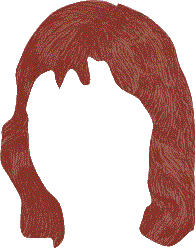| This problem goes to the heart of painting
and is better discussed with reference to the lesson called 'The
Pearl'. We all know what hair feels like, its texture, its color, its
breaking strain, and its usefulness in keeping the sun off our head. We
can love it or hate it. We spit it out with disgust when it invades our
mouth and admire it lustre and beauty when it cascades the bare shoulders of a beautiful
woman. All this has everything, and nothing, to do with painting hair. As I keep pointing out the concept of something must be married with its scientific reality before you can truly paint it.
Before we open our tool box of painting techniques
and deal with the problem of the hair let us recall the
pearl as it provides us with an example that explains the rules a painter
uses to render convincing existence.
Are the pearls real?
Things only exist as they relate to other things.
Without light (place the pearl in a dark room) the pearls will cease to
exist. The question is - without light does everything cease to exist?
Does an ant need to be a mathematician to know it walks on six legs? If
it can only count to five does it mean it must walk with a limp?For the
painter the answer is yes. Like Einstein's famous equation light is everything
to the artist, the great unifying constant.
In the lesson on the pearl, by beginning with the room, the window, the table, and the observer I first created an environment (for variation I selected objects with both curves
and straight lines). It is always useful to create the environment first.
- either in the imagination or by physical positioning. Since it is semi-reflective the manner the pearl interacts with this environment becomes the 'reality' of the pearl.
The painter lives his or
her life by investigating relationships between objects under the influence
of light. The painter's job is the discovery of the general rules and their
employment in creating an imagined reality - that is the joy for the boundries are endless.
But the mortal truth you ask? Who wants the truth? Let us sweep that off
the table and crush it like a bug! Dangerous stuff eh? No wonder artists
sometimes lose their grip in reality!
Mmm ... so to paint the hair we must create
its environment?
There are really only four elements in this picture. The face, hair, background
and the light. Unfortunately the face is front lit which restricts any
opportunity for secondary light effects or a nicely modulated turning point.
First I will slightly smooth the facial contours as they will otherwise compete to much with the hair and background.
| Next I create a background echoing all the
colors in the face and the darks in the hair. Now you can see the problem.
As soon as the background was applied (Fig 4) the hair, although nicely
rendered, becomes a foreign object ... and excessively light. |

It is not major problem however.
Let us separate the hair and apply a screen tint of a warm dark. Say
value 2 at 50% for the more mechanically minded. With paint I would simply
use a alizarin - raw umber glaze. Note how the texture is not lost. Saves
work later. Next is the favourite part - soften the edges and lose some
of the texture. |

Explanation: the human mind does not
like to be overloaded with too much detail, particularly in painting. It
revels in its ability to complete the picture without help, and it must be allowed
the (hazy bits) to do this. The degree you allow this says something
about your estimation of your proposed audience.
My rule is to always assume they are smarter than you, in other words leave
plenty of for the imagination. |

Fade in fade out...
STUDENT ACTIVITY: Find two examples of paintings where detail is overdone and two more where it is insufficient - in your opinion! Allow 40min.
|